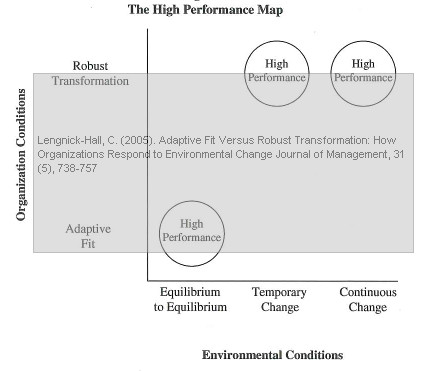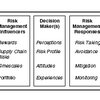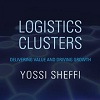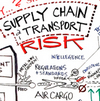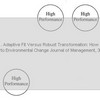 Many businesses believe themselves to be nested in a stable environment and are confounded when things suddenly change, and the world today no longer is the same world it was yesterday. Adapt or transform, that is the question, and in Adaptive Fit Versus Robust Transformation: How Organizations Respond to Environmental Change, written by Cynthia Lengnick-Hall and Tammy Beck in 2005, both options are explored. While adaptation may work temporarily, transformation and building a resiliency capacity is what works best in the long run. What is it about resilience that is so important, and most importantly, why?
Many businesses believe themselves to be nested in a stable environment and are confounded when things suddenly change, and the world today no longer is the same world it was yesterday. Adapt or transform, that is the question, and in Adaptive Fit Versus Robust Transformation: How Organizations Respond to Environmental Change, written by Cynthia Lengnick-Hall and Tammy Beck in 2005, both options are explored. While adaptation may work temporarily, transformation and building a resiliency capacity is what works best in the long run. What is it about resilience that is so important, and most importantly, why?
The components of resilience
Resilience. A key ingredient in supply chain risk management. Also a key ingredient in logistics risk management, as my recent book review of Risicomanagement en Logistiek points out. In that book the authors apply a framework with three types of resilience to logistics management in order to show what goes into the making of a resilient enterprise. This resilience framework splits resilience into cognitive resilience, behavioral resilience and contextual resilience, which must all come together for resilience to emerge, and is referenced in the book as taken from this article. When I wrote my review of the book above I had not yet read the article itself, so my understanding of the three types of resilience came from the book alone, so here is the full review of the source.
Adapation
The notion of adaption implies that organizations adapt to uncertainty and surprise changes by taking deliberate, intentional and rational steps to regain equilibrium, as championed by Chakravarthy (1982), who proposed a framework of adaptive fit, with three states: unstable fit, stable fit and neutral fit. An unstable fit comes as a result of a defensive strategy towards the change, while a reactive strategy fosters stable fit, and a proactive strategy that looks ahead and anticipates many possible changes promotes neutral fit. The fit assumes that the environment shifts from one state of equilibrium to another, and that the organization is able to adapt to this. However, increasing supply chain complexity and a highly dynamic global business world is not stable, it is turbulent, and demands a new way to managing supply chain network risk: robust transformation.
Transformation
Robust transformation, so the authors say, is defined as
a deliberately transient, episodic response to a new, yet fluid, environmental condition.
Like adaptive fit, robust transformation enables a firm to accommodate the level of complexity displayed in its environment, and it enables a firm to capitalize on environmental changes in ways that create new options and capabilities. But it does not trigger the firm’s immune system response, to use the authors’ own words.
Three responses
Environmental change invokes three responses in organizations:
- First, an implementation of (new) routines in response to change
- Second, routines result in an organizational change
- adaptive fit
- robust transformation
- reinforcement of established organization
- Third, organizational change results in performance consequences, short-term and long-term
The authors stress that there is no one right or wrong response here; the type of environmental change and duration of environmental change is what should determine which way to respond.
Routines and Complexity
Organizational routines are instrumental in how environment complexity and environmental changes are handled by firm. Three main options exist:
- Routines that disregard complexity, where habitual patterns override any attempt at actively managing complexity, by withdrawing from and avoiding change or by escalating committment and continue on the initially set course until it fails.
- Routines that reduce complexity, where organizations seek adaptive fit by emphasizing order and stability, by regulating interactions and relationships and by limiting differentiated interpretations of the environmental change and how to respond to it.
- Routines that absorb complexity, where organizations maintain a broad repertoire of options and enough action flexibility to create effective and contingent responses.
The first is perhaps a sort of see no evil, hear no evil, do no evil, “ignore it and it will go away” kind of response. Unfortunately, this sort of risk management by ignorance or avoidance is not unheard of in supply chain management. The second probably works well as a quick response getting back to business as usual as soon as possible. The third requires a company that takes comfort in chaos and that thrives in an environment of creativity and continuous organizational learning, something that in itself promotes organizational resilience, as I wrote about in a previous post.
Performance Consequences
Each type of environmental change and organizational (pre-)conditions and the resulting response leads to different performance outcomes. Success is only possible with the right response, under the right conditions, matched with the right change, as illustrated in the figure below:
Resilience capacity
This is the final part of the article that sums up the what is said above, and here the three components of resilience capacity that I described in my review of Risicomanagement en Logistiek are detailed:
- Cognitive resilience
- Behavioral resileince
- Contextual resilience
The first is what enables an organization to notice, interpret, analyze and formulate appropriate and ingenious responses beyond mere survival. The second is what enables a firm to learn about a situation and what moves a firm forward in a collaborative manner. The third is what provides the setting for using the previous components and is marked by deep social capital and a broad network of resources.
Resilience capacity, according to the authors, is learned. It is developed and honed over time, with every new change the firm encounters and successfully (or unsuccessfully, i.e. learning from failures) resolves. Most importantly, resilience capacity will lead the company to correctly judge the proper response to environmental change: complexity absorption and robust transformation for temporary or perpetual change, and than adaptive fit for skipping from one equilibrium to the next.
Conclusion
When looking into supply chain risks and how organizations should face these risks, which is the main topic for this blog, organizational change is indisputably one issue that should be considered. Resilience has grown to become they key ingredient in supply chain risk management. However, supply chain resilience does not come from looking at the supply chain alone; changing routines and processes cannot create resilience. As Ken Simpson wrote in one of his most recent posts on developing resilience,
Culture and structure are important starting points in creating the environment for resilience. Creating the environment to become resilient requires engagement at strategic levels and as part of overall organisational development.
Resilience can only come from an inner transformation of the whole organization. I think today’s article has a lot to offer and supply chain management and logistics can benefit a great deal from including social and organizational sciences in their thinking, as James Stock already said in 1997.
Reference
Lengnick-Hall, C. (2005). Adaptive Fit Versus Robust Transformation: How Organizations Respond to Environmental Change Journal of Management, 31 (5), 738-757 DOI: 10.1177/0149206305279367
Author links
- utsa.edu: Cynthia Lengnick-Hall
- uncc.edu: Tammy E Beck

